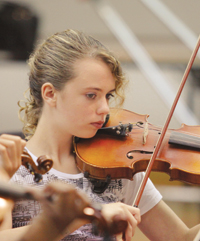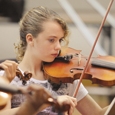 At the beginning of the school year directors take stock of the orchestra room, equipment, and library. It is also a wonderful time to reassess students’ playing habits and insist on high standards. As students return to the classroom, well-rested after summer vacation, take this opportunity to bring the ensemble to a higher level and experiment with new teaching techniques.
At the beginning of the school year directors take stock of the orchestra room, equipment, and library. It is also a wonderful time to reassess students’ playing habits and insist on high standards. As students return to the classroom, well-rested after summer vacation, take this opportunity to bring the ensemble to a higher level and experiment with new teaching techniques.
1Equipment Make sure all of the school instruments are in good repair and easy to tune. Stock up on extra mutes, rockstops, strings, rosin, cleaning cloths and shoulder rests. Keep a box of pencils near a pencil sharpener and have students take a pencil out for rehearsal and return it to the box at the end of class. As students come into the classroom, check their equipment to make sure there is enough hair on the bow. Pegs and fine tuners should move easily and be in convenient positions. Strings should be wrapped cleanly and shoulder rests should be set to the appropriate height. Reserve part of the first class of the year to discuss instrument maintenance. Make sure students know not to touch the wood of their instruments or the bow hair with their hands. Leave time at the end of each class to wipe off instruments and put them away properly. Create an environment in which students care for instruments and treat all of the instruments in the room with respect.
2Playing Position. Insist on an excellent playing position. Often violinists are slouched in their chairs with scrolls pointing toward the floor. Cellists and bassists tend to lean over instruments and let their heads drop forward. Make sure cello chairs and bass stools support proper alignment. Teach students basic arm and back stretches that promote strong playing positions and healthy muscles. Have students stand up and stretch every ten minutes. For violinists and violists, practicing standing up can improve playing positions almost instantly. Experiment with revolving seating so that everyone gets a chance to sit in front. Have sections sit in different formations or place yourself in the center of the room with the orchestra around you. Students who are buried in the back of the orchestra tend to have the weakest positions because they don’t think anyone can see them.
3Tuning Students often tune quickly and haphazardly, stating “that is good enough for now” or “my peg is stuck so I will just adjust to it.” Budget enough time for the ensemble to tune thoroughly and accurately. Use a tuner and develop a tuning policy. If the concertmaster supplies the A, have her play the pitch with a solid, bold tone. Have sections tune separately so that everyone can hear themselves. Stronger students can help less advanced students who struggle with tuning. An orchestra that tunes well has a much greater chance of playing repertoire in tune.
4Rhythm Students who count accurately and subdivide automatically learn music quickly. Include rhythm exercises in each class. Extract challenging rhythms from pieces students are studying and practice the rhythms on open strings and in scales. Use a rhythm exercise as a warm-up or to work on a specific bowing technique. Each week, focus on a different meter. Practice tapping rhythms, saying rhythms, and playing rhythms pizzicato. Hook the metronome up to a speaker so that everyone can hear it. Practice with bowed subdivisions and fill-ins. Create a packet of one hundred rhythm exercises and challenge the students to perfect all of them. Students who complete the rhythm challenge can receive a small reward such as a new pencil or mute.
5Technique Teachers often are tempted to gloss over technical exercises because class periods are short and there is always an upcoming concert for which to prepare. Try to include a technical segment in each class period. Have a scale plan so students cover all the major and minor scales each semester. Reserve two weeks at the end of the semester to review the most challenging scales and arpeggios. Practice scales with numerous bowing variations so that technique is not solely associated with intonation. Bowing variations can include slurs and staccato bows (2-24 notes per bow), brush stroke with 2-4 repetitions per note, colle bow strokes at the frog, and sautille strokes with 4 or 8 repetitions per note. Encourage the students to invent their own bowing variations for scales and incorporate them into group scale practice.
6Tone Students are assigned difficult repertoire to stretch their technique and keep them engaged. Take time out from drilling notes to work on the beauty of the sound. Have the ensemble practice easy melodies in unison to work on vibrato and bow distribution. Practice melodies all at the frog, all in the middle, and all at the tip. Practice vibrating just first finger, just second finger, or just third finger. Experiment with the amount of bow hair used, from flat hair to a tilted bow. Practice melodies with different dynamics and work on the adjustments that should be made to successfully articulate each dynamic. Section members should play with the same bowings, in the same part of the bow, and with the same amount of bow. Have each student listen to the person on their left, right, and across the room and try to blend into the other player’s sound.
7Composition Keep manuscript paper in the orchestra room and encourage students to experiment with composition. They could create rhythm exercises or write out intervals and simple melodies for the orchestra to play. Writing out scales by memory helps players understand key signatures and intervals. Students who compose learn music on a deeper level. Composition also prepares serious students for more advanced studies of music theory.
8Chamber music Integrate chamber music into the program. Split members of the orchestra into smaller groups and have them work on the orchestra music without a conductor. Organize weekly chamber music readings in which strong and weak students read chamber music together. Form a trio or quartet of strong students who can perform in the community and boost visibility for the program. Playing chamber music improves students’ ability to lead, listen, and breathe together.
9Mentors Bring in guest coaches to present masterclasses and teach sectionals. Invite professional musicians to perform as soloists with your orchestra. Seeing and hearing musicians play at a high level is a great motivator for students. Many orchestra programs do not have adequate funds to bring in guest coaches and performers. However, there are usually young teachers in the area who are trying to build private studios and establish a name in the community. They are often willing to present a masterclass or perform at a low cost in return for the publicity and connections they will acquire.
10Watch, Listen, and Learn Assign listening projects to students. If there are nine violists in the orchestra, each can listen to a Beethoven symphony. Sixteen violinists can study the sixteen Beethoven string quartets. Have recordings playing as students enter for class. Watch YouTube videos of master performers and talk about what makes these artists great. Advanced students can perform for the other students. Encourage students to attend concerts and recitals. If tickets to a symphony concert are too expensive, ask a local orchestra if you can bring your group to a dress rehearsal. Students who are exposed to great music and musicians become more excited about their own practice and performance.






